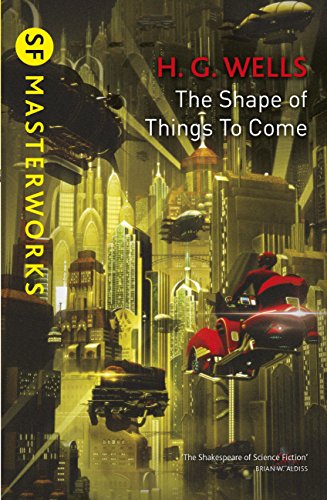On with Vintage Science Fiction Month! H.G. Wells’ The Shape of Things to Come (1933) purports to be the “dreamed” history of the next hundred and fifty years of human experience. Be warned: it’s serious future fictional history without a character or action-driven plot, though there are a few strong personalities who take the spotlight in the later chapters. Possibly inspired by Olaf Stapeldon’s much more ambitious Last and First Men, which covers the next few million years of human development, The Shape of Things to Come presents itself as an edited version of the notes of a famous diplomat who envisioned a very different world from the one he lived in.
I first became aware of this book after seeing the 1936 film, Things to Come, with a script by Wells. It’s one of the most ambitious early science fiction movies that embodies the outlines of this imagined future in a more personal story of successive generations of a family that plays a leading role in world change. I won’t try to summarize the film until I’ve had a chance to see it again and read Wells’ own short stories that provided the basis for its plot. Suffice it to say, it’s a knockout of a film for that time.
The Shape of Things to Come is frankly heavy reading which Wells tries to enliven with interruptions of the diplomat’s text with observations about the man’s struggle to write certain parts of it.
The opening chapter is actually one of the most interesting. In it, the “editor” describes his acquaintance with the diplomat, Dr. Philip Raven, who slowly lets on over several meetings that he has experienced moments of seeing the future, especially in the strange state between dreaming and waking.
Wells describes Raven as distinctly un-English, having a vaguely eastern European background and using lots of hand gestures as he spoke. Raven, normally having to censor himself in his role as diplomat, feels freer talking to Wells and eventually makes a confession:
“For some years off and on — between sleeping and waking — I’ve been — in effect — reading a book. A non-existent book. A dream book if you like. It’s always the same book. Always. And it’s a history.”
The Shape of Things to Come, Kindle edition, page 4
After Raven’s death, all his notes and writings about this dreamed book are left to Wells who then, we are told, takes three years to get the material into fully readable form. It purports to be a history of world affairs from the vantage point of 2106.
The earlier segments describing all the disasters, wars and plagues that leave earth and its much reduced population depleted and demoralized I found a bit tedious. This part would have been more intriguing to read when it was published in 1933 before we knew how things would turn out with Hitler and Stalin and the rest.
And there are all-too-familiar limitations to Wells’ worldview. The perspective is purely European and rooted in a world of empires and misses the disruptive force of nationalism that tore all those European empires apart.
The writer or dreamer also had no use for women, who seem to play almost no role in “Mankind’s” evolution except in a few cases in which they are “muses” to a couple of leading figures. So it’s men all the way in a book dominated by masculine pronouns.
But the interest of the book, for me, lies in its detailed imagining of how humanity might endure one disaster after another to emerge with a Star Trek-like vision of a future where want and greed are abolished. I’m always torn about utopia-like versions of the future. I want to imagine a hopeful future, sure, but Wells cuts out a lot to get there.
His vision of the middle decades of the twentieth century is pure disaster – economic collapse lasting decades, terrible wars that obliterate whole cities and the destructive dominance of small-minded nationalisms and power struggles. The world descends into chaos as governments collapse and a plague drastically cuts down the population. All the damage is done by the 1960s.
What saves the day is the eventual emergence of a small cadre of highly disciplined leaders who manage to take over the key systems of world transport, communication, food production and distribution, and most important in this scheme, education. In its early version, this is the Dictatorship of the Air that takes control of all airports and the means of manufacturing planes and other forms of transportation.
Wells envisioned a world unified by information networks, headquartered in Barcelona, that spreads a message of hope and humanistic altruism around the world. A world mind, if you will, that helps bring together the remnants of a world torn apart by the narrow minded economic and religious systems of the past.
Over the course of a century or so, beginning in the late 1960s, this disciplined minority of the Dictatorship gradually evolves into a World Council and eventually even that is dissolved as the system functions without centralized control. That is possible because all the changes bring about a fundamental shift in human nature.
The World Council eliminates usury and all forms of purely finance-based institutions, which have victimized humanity for centuries, institutes its own form of currency based on energy units, and leads a broad uplifting of humanity through education and science. Wells believed that even the most humble of people could be uplifted through education to become creative contributors to society.
Organized religion had no place in this scheme. Wells describes attacks by the early Dictatorship on the Catholic Church, which is forcibly suppressed. Islam’s holy places are occupied, and this religion withers away along with the study of Arabic. Judaism is characterized in pretty anti-semitic terms as the archaic religion of people trying to isolate themselves from the world and clinging to a fantasy of Zionism. For Wells, the Jews are all assimilated into the dominant culture, and Judaism disappears.
So also national governments and the greed-driven ethic of free-for-all capitalism fall by the wayside. Thanks to advances in medicine, people live longer, and their lives are no longer plagued by the grinding power of debt. Over the course of a century, a purpose-driven humanity, all its material needs satisfied, is educated into a new mindset where conflict over scarce resources or racial divides is no longer necessary.
Wells didn’t see any problem with a single dominant world culture and economic system. This was his “dream” as set forth in The Shape of Things to Come. Everyone advances, everyone is taken care of, the little physical labor still required is performed by the world’s youth in a two-year period of public service.
There is an interesting idea of individuality in this vision of the future. While admitting that it was a “more intelligent minority” that took advantage of the confusion and exhaustion of the world to institute a new system, it was really the victory of “creative power” working through this minority that made change possible.
“But our Modern State has neither absorbed nor destroyed individuality, which now accepting the necessary restrictions upon its material aggressiveness, resumes at every opportunity its freedom and enterprise upon a higher level of life. … We work, we think, we explore, we dispute, we take risks and suffer — for there seems no end to the difficult and dangerous adventures individual men and women may attempt; and more and more plain does it become to us that it is not our little selves, but Man the Undying who achieves things through us.”
The Shape of Things to Come, Kindle edition, Page 255
I can’t rate this really highly as a reading experience, unless you’re into straight historical narrative that looks for the impersonal forces working themselves out rather than the sort of vivid personality-based historical writing that is so popular now. But there are a staggering number of interesting ideas about many aspects of civilization to be found in The Shape of Things to Come. That made it worthwhile for me. I think the 1936 film version is a much more vivid experience, and I’ll take that up soon.






I don’t know that this would be my cup of tea, but I enjoyed reading your thoughts about it. Wow, what a big project to undertake!
Thanks for dropping by – you might like the film, dated as it is in many ways. A lot of its images are forever in my memory.